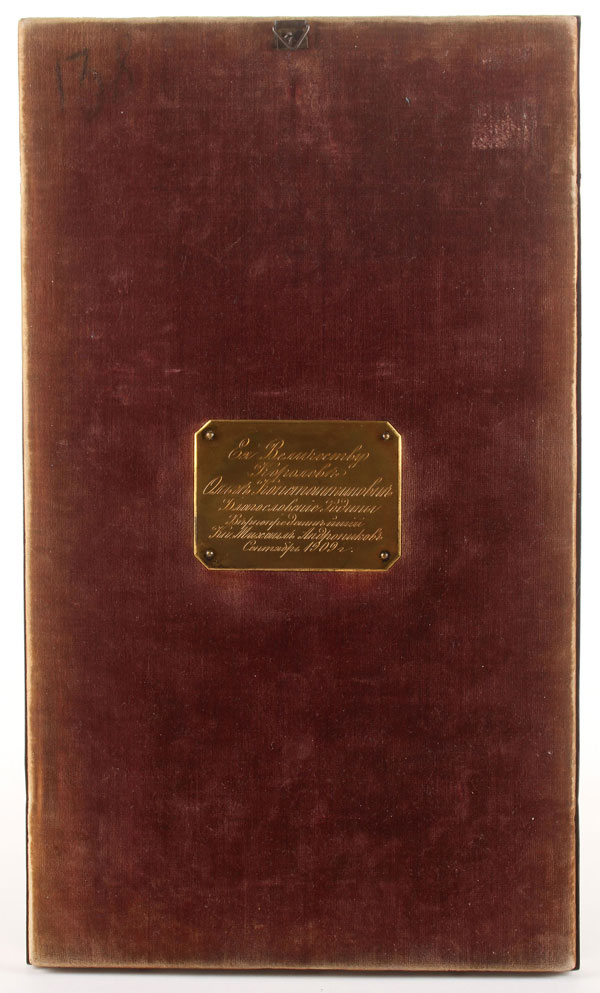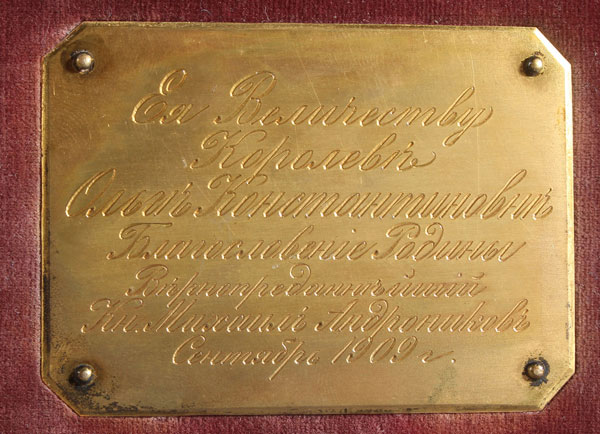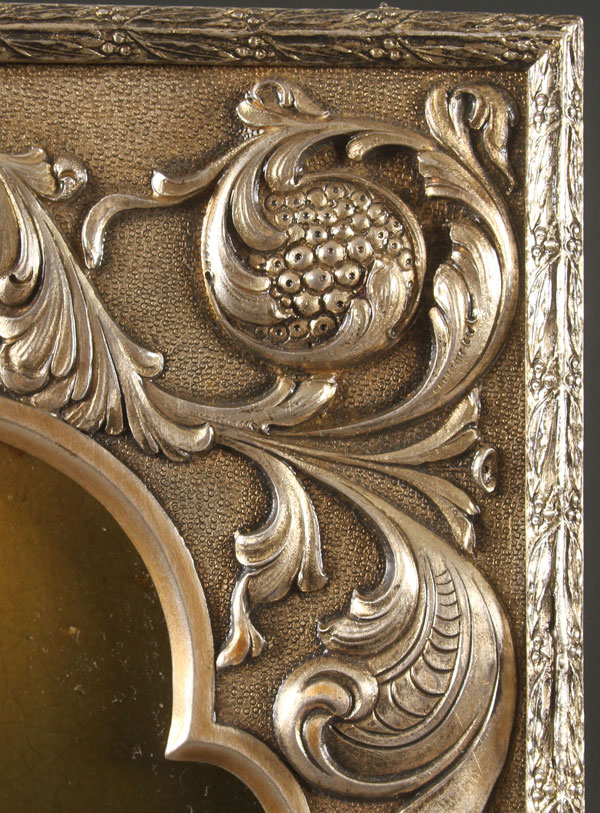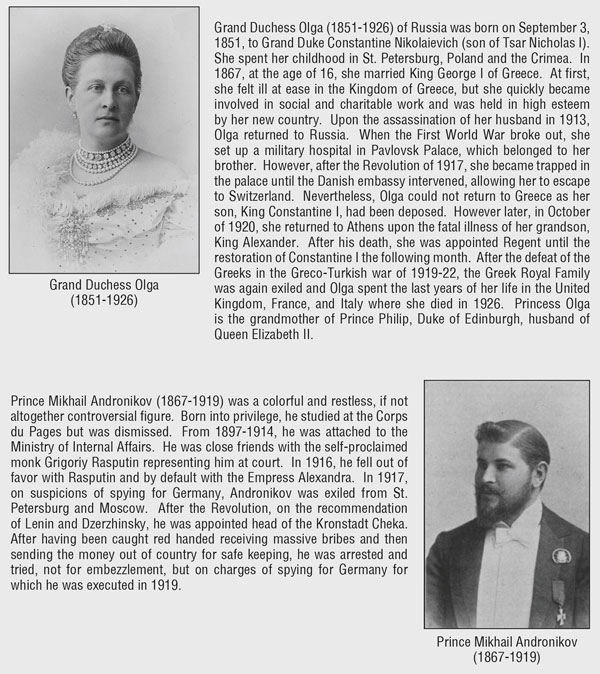13
AN IMPORTANT IMPERIAL RUSSIAN PRESENTATION ICON OF SAINT ANNA KASHINSKAYA, VLADIMIROV, ST.
Grand Duchess Olga (1851-1926) of Russia was born on September 3, 1851, to Grand Duke Constantine Nikolaievich (son of Tsar Nicholas I). She spent her childhood in St. Petersburg, Poland and the Crimea. In 1867, at the age of 16, she married King George I of Greece. At first, she felt ill at ease in the Kingdom of Greece, but she quickly became involved in social and charitable work and was held in high esteem by her new country. Upon the assassination of her husband in 1913, Olga returned to Russia. When the First World War broke out, she set up a military hospital in Pavlovsk Palace, which belonged to her brother. However, after the Revolution of 1917, she became trapped in the palace until the Danish embassy intervened, allowing her to escape to Switzerland. Nevertheless, Olga could not return to Greece as her son, King Constantine I, had been deposed. However later, in October of 1920, she returned to Athens upon the fatal illness of her grandson, King Alexander. After his death, she was appointed Regent until the restoration of Constantine I the following month. After the defeat of the Greeks in the Greco-Turkish war of 1919-22, the Greek Royal Family was again exiled and Olga spent the last years of her life in the United Kingdom, France, and Italy where she died in 1926. Princess Olga is the grandmother of Prince Philip, Duke of Edinburgh, husband of Queen Elizabeth II.
Prince Mikhail Andronikov (1867-1919) was a colorful and restless, if not altogether controversial figure. Born into privilege, he studied at the Corps du Pages but was dismissed. From 1897-1914, he was attached to the Ministry of Internal Affairs. He was close friends with the self-proclaimed monk Grigoriy Rasputin representing him at court. In 1916, he fell out of favor with Rasputin and by default with the Empress Alexandra. In 1917, on suspicions of spying for Germany, Andronikov was exiled from St. Petersburg and Moscow. After the Revolution, on the recommendation of Lenin and Dzerzhinsky, he was appointed head of the Kronstadt Cheka. After having been caught red handed receiving massive bribes and then sending the money out of country for safe keeping, he was arrested and tried, not for embezzlement, but on charges of spying for Germany for which he was executed in 1919.
Princess Anna Kashin (1280 - 2 October 1368) was a Russian princess from the Rurik Dynasty. In 1324, she married Prince Mikhail of Tver and together they had five children. After the death of her husband, Anna carried out an old desire "in silence to work only for God." She took vows in Sofia's Monastery in Tver and adopted the name Evfrosiniya. In 1365, the youngest son of the princess, Vasiliy, her only child remaining alive by that time, entreated his mother to move to his principality. The Upensky Monastery was built in Kashin, and there the saint accepted the schema with the name of Anna. She died of old age on 2 October 1368, and was buried in the cathedral temple of the Blessed Virgin.
The name of Princess Anna was forgotten for many centuries. It was during the 1611 siege of Kashin by Lithuanian troops that Anna appeared to Gerasim, Sexton of the Dormition Cathedral, and it is said that she prayed to the Saviour and Our Lady for deliverance of her city from foreigners. Her relics were reported to work miracles. The synod of the Russian Orthodox Church convened in 1649 and declared her relics worthy of a universal homage. The princess was glorified as a saint. 28 years later, Patriarch Joachim addressed the Moscow Synod with a suggestion to decanonize her because of the uncommon veneration and esteem for Anna among the Old Believers. It was traditionally thought the Old Believers chose Anna as their palladium because the princess was represented on icons as making the Sign of the Cross with two fingers, as the Old Believers practiced, rather than with three, as official church policy required after Patriarch Nikon in 1656. However, writings used by the Old Believers show that one of the reasons they venerated her so highly was that her incorrupt body, on display, showed her hand in the two-fingered Sign of the Cross favoured by the Old Believers, vindicating their stance. Despite numerous efforts of the Church authorities to "correct" the situation, her hand always went back to the same two-fingered position. In response, Patriarch Joachim removed the relics of Anna from public view. In 1678, the Grand Council of the Russian Orthodox Church, decanonized Anna of Kashin permitting only prayer for her. It was not until 1909 that the Russian Orthodox Church glorified Anna again.
Based on the date inscribed on the dedicatory plaque of the offered icon, it would seem that it was related to two events simultaneously, the birthday of Queen Olga (September) and the year in which Saint Anna Kashinskaya was once again glorified by the church (1909).
Grand Duchess Olga (1851-1926) of Russia was born on September 3, 1851, to Grand Duke Constantine Nikolaievich (son of Tsar Nicholas I). She spent her childhood in St. Petersburg, Poland and the Crimea. In 1867, at the age of 16, she married King George I of Greece. At first, she felt ill at ease in the Kingdom of Greece, but she quickly became involved in social and charitable work and was held in high esteem by her new country. Upon the assassination of her husband in 1913, Olga returned to Russia. When the First World War broke out, she set up a military hospital in Pavlovsk Palace, which belonged to her brother. However, after the Revolution of 1917, she became trapped in the palace until the Danish embassy intervened, allowing her to escape to Switzerland. Nevertheless, Olga could not return to Greece as her son, King Constantine I, had been deposed. However later, in October of 1920, she returned to Athens upon the fatal illness of her grandson, King Alexander. After his death, she was appointed Regent until the restoration of Constantine I the following month. After the defeat of the Greeks in the Greco-Turkish war of 1919-22, the Greek Royal Family was again exiled and Olga spent the last years of her life in the United Kingdom, France, and Italy where she died in 1926. Princess Olga is the grandmother of Prince Philip, Duke of Edinburgh, husband of Queen Elizabeth II.
Prince Mikhail Andronikov (1867-1919) was a colorful and restless, if not altogether controversial figure. Born into privilege, he studied at the Corps du Pages but was dismissed. From 1897-1914, he was attached to the Ministry of Internal Affairs. He was close friends with the self-proclaimed monk Grigoriy Rasputin representing him at court. In 1916, he fell out of favor with Rasputin and by default with the Empress Alexandra. In 1917, on suspicions of spying for Germany, Andronikov was exiled from St. Petersburg and Moscow. After the Revolution, on the recommendation of Lenin and Dzerzhinsky, he was appointed head of the Kronstadt Cheka. After having been caught red handed receiving massive bribes and then sending the money out of country for safe keeping, he was arrested and tried, not for embezzlement, but on charges of spying for Germany for which he was executed in 1919.
Princess Anna Kashin (1280 - 2 October 1368) was a Russian princess from the Rurik Dynasty. In 1324, she married Prince Mikhail of Tver and together they had five children. After the death of her husband, Anna carried out an old desire "in silence to work only for God." She took vows in Sofia's Monastery in Tver and adopted the name Evfrosiniya. In 1365, the youngest son of the princess, Vasiliy, her only child remaining alive by that time, entreated his mother to move to his principality. The Upensky Monastery was built in Kashin, and there the saint accepted the schema with the name of Anna. She died of old age on 2 October 1368, and was buried in the cathedral temple of the Blessed Virgin.
The name of Princess Anna was forgotten for many centuries. It was during the 1611 siege of Kashin by Lithuanian troops that Anna appeared to Gerasim, Sexton of the Dormition Cathedral, and it is said that she prayed to the Saviour and Our Lady for deliverance of her city from foreigners. Her relics were reported to work miracles. The synod of the Russian Orthodox Church convened in 1649 and declared her relics worthy of a universal homage. The princess was glorified as a saint. 28 years later, Patriarch Joachim addressed the Moscow Synod with a suggestion to decanonize her because of the uncommon veneration and esteem for Anna among the Old Believers. It was traditionally thought the Old Believers chose Anna as their palladium because the princess was represented on icons as making the Sign of the Cross with two fingers, as the Old Believers practiced, rather than with three, as official church policy required after Patriarch Nikon in 1656. However, writings used by the Old Believers show that one of the reasons they venerated her so highly was that her incorrupt body, on display, showed her hand in the two-fingered Sign of the Cross favoured by the Old Believers, vindicating their stance. Despite numerous efforts of the Church authorities to "correct" the situation, her hand always went back to the same two-fingered position. In response, Patriarch Joachim removed the relics of Anna from public view. In 1678, the Grand Council of the Russian Orthodox Church, decanonized Anna of Kashin permitting only prayer for her. It was not until 1909 that the Russian Orthodox Church glorified Anna again.
Based on the date inscribed on the dedicatory plaque of the offered icon, it would seem that it was related to two events simultaneously, the birthday of Queen Olga (September) and the year in which Saint Anna Kashinskaya was once again glorified by the church (1909).
World Treasures-Featuring Important Russian, European, Asian & American Fine Art
Sale Date(s)
Venue Address
General delivery information available from the auctioneer
SHIPPING NOTICE:
Jackson's is your sole and only source for one stop packing and shipping. With over 50 years of experience, our professional, affordable and efficient in-house shipping department will be happy to provide you a fair and reasonable shipping quote on this lot. Simply email us before the auction for a quick quote: shipping@jacksonsauction.com or call 1-800-665-6743. Jackson's can expertly pack and ship to meet any of your needs. To ensure quality control Jackson's DOES NOT release to third party shippers.
Important Information
Buyers Premium: 20%
Preview:
Tuesday, June 9th - Friday, June 12th
9:00 A.M. - 5:00 P.M.
Saturday, June 13th - Sunday, June 14th
10:00 A.M. - 5:00 P.M.
Monday, June 15th
9:00 A.M. - 8:00 P. M.
Payment: For bidders whose credit has not yet been established with our firm, you may apply for a check acceptance account by filling out a bidder approval form (available from www.jacksonsauction.com). This should be done prior to the sale. All property must be paid for within 7 business days after auction unless otherwise arranged with an authorized staff member. Invoices must be paid in full immediately upon receipt. In the event of nonpayment, your signature on bid form is authorization to charge your credit card for purchases and all additional charges. Jackson's may impose, and the purchaser agrees to pay, a 1.5% per month late charge on the total purchase price in invoices that are outstanding over thirty (30) days after the date of the sale
Shipping:
Our fine art and antique shipping department is experienced in coordinating shipping arrangements for any variety of items purchased at auction
Our Approved Carriers are:
•UPS
•UPS-SCS (up to $500)
•FedEx (up to $500)
•USPS
•Vintage Transportation
•Art Transit
•Plycon
Third Party Shippers:
•UPS Store (Cedar Falls, IA) - 319-268-1705 or 319-268-1705
•UPS Store (Waterloo, IA) - 319-235-1800 or 319-235-1800
•The Postman - 319-236-1328 or 319-236-1328
•Pro Pak





















